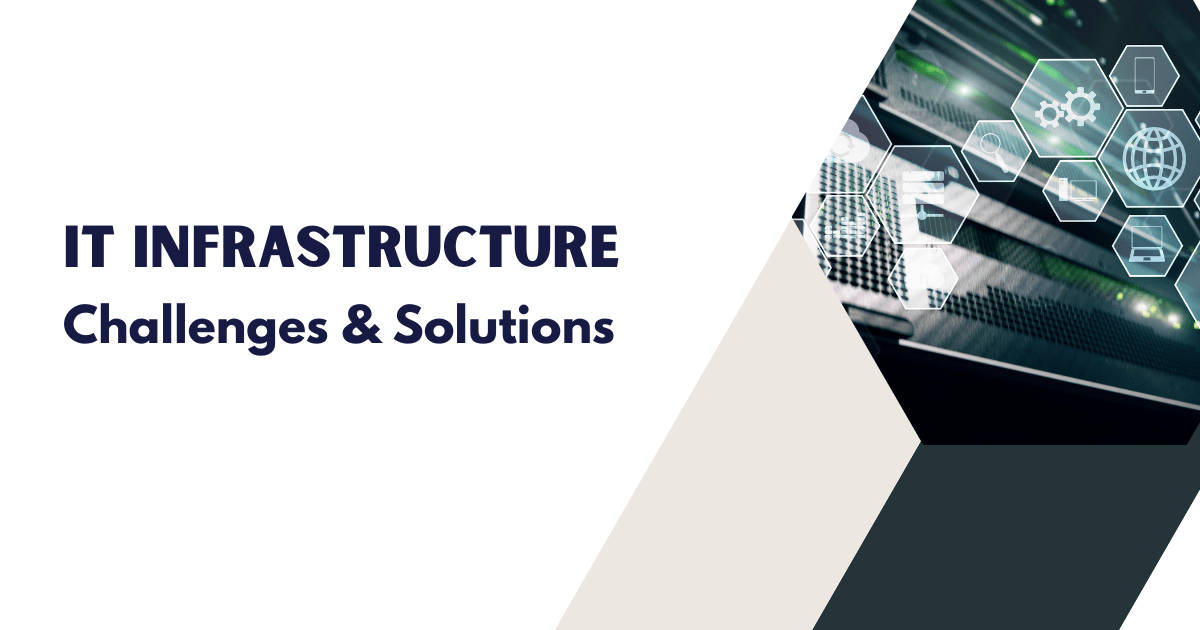Top 4 IT Infrastructure Challenges & Solutions
IT infrastructure plays an essential role in supporting business operations and growth. However, as companies grow and adapt to new demands, they encounter common IT infrastructure challenges that can slow performance, raise costs, and create security risks. This blog covers four key challenges in IT infrastructure, scalability and flexibility, cost management, data security and compliance, downtime and disaster recovery, and provides practical solutions for each.
IT Infrastructure Challenges
Scalability and Flexibility
- Businesses often struggle with the need to grow and adapt their IT infrastructure. As technology requirements shift, scaling becomes complex and costly, especially with outdated systems, limiting a company’s ability to expand resources as needed.
Cost Management
- Managing IT expenses is challenging, with high hardware, software, and support costs. Hidden expenses from underutilized resources or outdated technology can strain budgets, impacting a company’s financial health and diverting funds from other essential areas.
Data Security and Compliance
- Protecting sensitive information and complying with regulations like GDPR or HIPAA is critical as cyber threats evolve. Failing to meet standards can result in penalties, reputational damage, and lost customer trust.
Downtime and Disaster Recovery
- Unexpected disruptions, such as power outages or cyberattacks, can severely impact IT operations. Without a strong disaster recovery plan, companies risk prolonged downtime, which can lead to lost revenue and reduced customer satisfaction.
How to Overcome These Challenges
Upgrading IT Infrastructure
Upgrading IT infrastructure is essential for growth because it helps businesses overcome common challenges such as scalability, cost management, security, and downtime. As companies expand, their existing infrastructure may struggle to handle increased demands, making it difficult to scale resources efficiently. An outdated system can also result in higher maintenance costs and security vulnerabilities, exposing the business to potential risks. By upgrading IT infrastructure, companies can implement more flexible, cost-effective solutions, enhance data protection, and minimize downtime, ultimately enabling them to respond more effectively to new challenges and support future growth.
Achieving Scalability and Flexibility
Moving to cloud-based infrastructure solutions enables businesses to adjust their resources according to current needs, without the heavy costs associated with physical hardware. Cloud services allow for easy scaling up or down, while pay-as-you-go models help companies manage expenses more effectively. Virtualization is another method that can improve flexibility, allowing for smoother application deployment and efficient resource allocation. By adopting these options, companies can better respond to changes and support future growth.
Agrius IT offers a range of cloud-based solutions that help businesses scale their resources easily and flexibly. With Agrius IT, companies can efficiently manage changing demands without large upfront costs, staying prepared for future growth.
Improving Cost Management
To manage IT expenses, businesses can consider shifting to cloud or hybrid models, which combine both on-premises and cloud resources. These models often reduce costs since companies pay only for the resources they use. Regular cost audits help identify any underused resources, and automated monitoring tools can track real-time usage, making it easier to spot and remove unnecessary expenses. This approach ensures that companies stay within budget while optimizing resource allocation.
Enhancing Data Security and Compliance
A strong security and compliance strategy includes regular software updates, firewalls, encryption, and strict data access controls. Regular compliance audits ensure adherence to industry regulations, protecting both company and customer data. For businesses that lack internal resources, partnering with managed IT services adds security expertise and helps in staying updated on current threats. This approach supports a reliable security framework and reduces regulatory risks.
Reducing Downtime and Improving Disaster Recovery
Creating a disaster recovery plan is essential for minimizing downtime and maintaining business continuity. This plan includes regular data backups, redundant systems, and clearly defined emergency procedures. Many companies also choose cloud-based recovery options, which allow for quick data restoration in case of an outage. Testing the recovery plan routinely helps identify any areas for improvement. Investing in a strong recovery strategy allows businesses to protect data and minimize disruption during unforeseen events.
Agrius IT provides disaster recovery solutions, including cloud-based backups and emergency response planning. These services help businesses protect their data and minimize downtime during unexpected disruptions.
Conclusion
IT infrastructure challenges can be complex, but with the right solutions to address these challenges, businesses can create more reliable, scalable, and secure systems. Agrius IT offers effective solutions for these challenges, helping companies address issues like scalability, cost management, security, and downtime. By proactively tackling these challenges, businesses are better equipped to support their operations and prepare for future growth.



